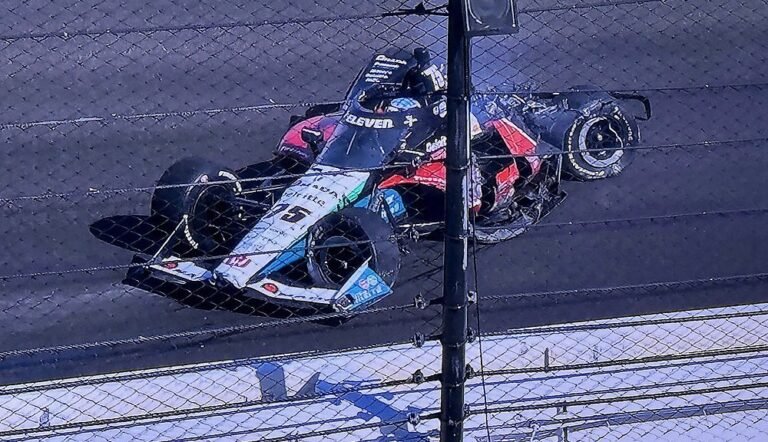Takuma Sato’s Rollercoaster Test Experience
Takuma Sato, a veteran driver known for his speed and resilience, had a notable performance during the two-day Indy Open Test. He showcased his skills by consistently ranking among the fastest, securing the third-fastest time on Wednesday and later improving his position to second during a high-boost qualifying simulation session on Thursday morning. However, his promising momentum took a sudden turn when he became the second driver to make contact with the Turn 1 wall.
The incident unfolded soon after fellow driver Kyle Larson of Arrow McLaren/Hendrick Motorsports hit the same wall, sustaining only minor damage. Unfortunately, Sato was not as fortunate. As he navigated Turn 1, he lost control of his Rahal Letterman Lanigan Racing Honda, spinning out and colliding with the wall on the opposite side of his car. The impact sent him into a further rotation before coming to a stop in Turn 2. This crash not only marked a significant setback for Sato during the test but also highlighted the precarious nature of competitive racing.
Aftermath of the Incident
The damage to Sato’s vehicle was considerable, particularly to the rear of the car, which began leaking fluids upon impact. This necessitated the intervention of the AMR Safety Team, who promptly spread an oil-dry substance across the area to ensure safety on the track. Unlike Larson, who managed to exit his vehicle shortly after the crash, Sato took his time. He remained inside the car for over a minute, appearing to gather himself before he finally emerged. As he surveyed the wreckage, his demeanor reflected the mix of frustration and disappointment that often accompanies such situations.
Despite the crash, there were positives to take away from Sato’s performances leading up to the incident. His top lap speed of 232.565 mph marked the best no-tow lap of the day, demonstrating that he had command of his vehicle before the unfortunate turn of events. This was just a fraction short of Scott McLaughlin’s leading competition lap of 232.686 mph, which was achieved with the benefit of a tow – a common strategy in IndyCar racing to gain speed. Nevertheless, Sato’s ability to perform well amidst the pressures of simulation testing speaks volumes about his skill as a driver.
A Steady Recovery and the Road Ahead
Even after the accident, Sato remained composed and professional. He reassured everyone by stating, "Lost it. My body is fine," affirming that he suffered no physical injuries. This comment not only reflects his mental fortitude but also underscores the challenging nature of motorsport, where the risks are as high as the rewards. Soon after being released by IndyCar Medical, Sato was likely already focused on the next steps, planning for repairs to his car and strategizing for future races.
Driving in IndyCar is not for the faint of heart, as evidenced by the rapid succession of events that can change the course of a test session. This pressure cooker environment can be both exhilarating and daunting for drivers. Sato knows this all too well, having navigated the highs of winning the Indianapolis 500 and the lows of experiences like the one encountered at the test. Each outing on the track presents an opportunity for learning and growth, and Sato’s experience will surely contribute to his preparedness for the season ahead.
Looking Forward to the Season
As the IndyCar series gears up for an exciting season, drivers like Sato are keenly aware of the hard work that lies ahead. The challenges posed by the track, competing teams, and the sheer physicality of the sport will require not just speed but also a strategic mindset. Sato’s ability to bounce back from setbacks will be crucial as he seeks to leverage his competitive edge and navigate through to the race season successfully.
With many eyes on him, Sato’s ongoing journey through the IndyCar landscape will be closely watched. His experience and tenacity are attributes that not only inspire fans but also younger drivers looking to make their mark in racing. Sato’s story reminds us that every setback can also be a setup for a comeback, reinforcing the idea that resilience is essential in both racing and life.



